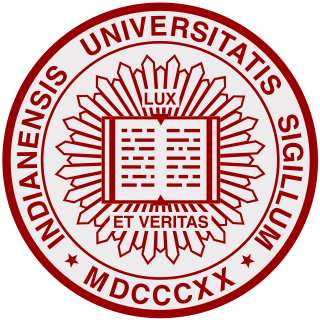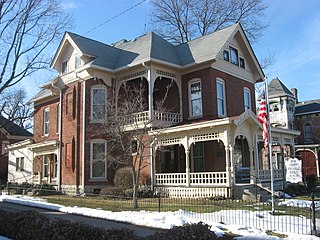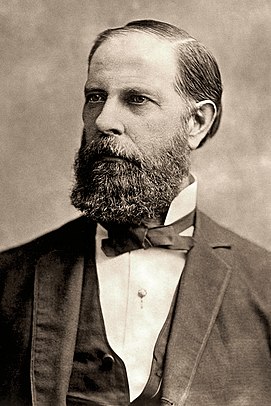
William Hayden English was an American US Representative from Indiana and the Democratic nominee for vice president in 1880. English entered politics at a young age, becoming a part of Jesse D. Bright's conservative faction of the Indiana Democratic Party. After a few years in the federal bureaucracy in Washington beginning in 1845, he returned to Indiana and participated in the state constitutional convention of 1850. He was elected to the Indiana House of Representatives in 1851 and served as its speaker at the age of twenty-nine. After a two-year term in the state house, English represented Indiana in the federal House of Representatives for four terms from 1853 to 1861, working most notably to achieve a compromise on the admission of Kansas as a state.
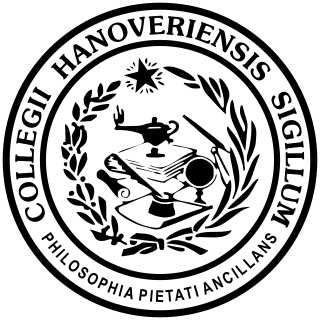
Hanover College is a private, co-ed, liberal arts college, in Hanover, Indiana. The college is affiliated with the Presbyterian Church (USA). Founded in 1827 by the Rev. John Finley Crowe, it is the oldest private college in Indiana. The Hanover athletic teams participate in the Heartland Collegiate Athletic Conference. Graduates of Hanover are known as Hanoverians.
Herman B Wells, a native of Boone County, Indiana, was the eleventh president of Indiana University (Bloomington) and its first university chancellor. He was pivotal in the transformation of Indiana University from a small, locally oriented college into a world-class institution of higher learning through expanded enrollment, recruitment of new faculty, construction of new buildings, new program offerings, and campus beautification projects. He remained steadfast in his support of IU's faculty and students, especially in the areas of academic freedom and civil rights. Wells began his career in banking, but served the university in a variety of faculty and administrative capacities during his seventy-year career at IU Bloomington: instructor and assistant professor, department of economics (1930–35; dean and professor of administration, school of business administration ; acting president ; president ; university chancellor ; interim president ; and chairman of the board of the Indiana University Foundation, as well as other leadership roles at the IU Foundation.

Paris Chipman Dunning was a Democratic state representative, state senator, senate president pro tempore, the tenth Lieutenant Governor, and the ninth Governor of the U.S. state of Indiana from December 26, 1848 to December 5, 1849. He is the only person to hold to every elected seat in the state government under the 1816 constitution. His brief term as governor was marked by the calling of a state constitutional convention and overshadowed by the national anti-slavery debate, where Dunning urged state leaders to issue and forward resolutions to Congress expressing opposition to the expansion of slavery. As a delegate to the subsequent convention, he successfully advocated legislative and educational reform. As the American Civil War broke out, he left the Democratic party and declared for the Union, personally raising many companies of soldiers for the war effort. He returned to the state senate during the war, and then resumed his law practice after his term ended. He remained popular in the state, and declined several nominations to run for office after retiring from politics.
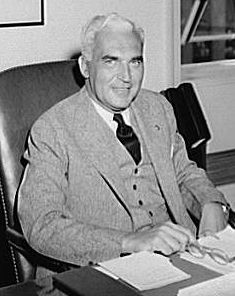
Paul Vories McNutt was an American diplomat and politician who served as the 34th Governor of Indiana, high commissioner to the Philippines, administrator of the Federal Security Agency, chairman of the War Manpower Commission and ambassador to the Philippines.
Lilly Endowment Inc., headquartered in Indianapolis, Indiana, is one of the world's largest private philanthropic foundations and among the largest endowments in the United States. It was founded in 1937 by Josiah K. Lilly Sr. and his sons, Eli Jr. and Josiah Jr. (Joe), with an initial gift of Eli Lilly and Company stock valued at $280,000 USD. As of 2014 its total assets are worth $9.96 billion.

Caleb Mills was an American educator who served as the Superintendent of Public Instruction in Indiana and was the first faculty member at Wabash College. He played a central role in designing the public education system of Indiana.

Maurice Clifford Townsend was the 35th Governor of the U.S. state of Indiana from 1937 to 1941. During his term he led relief efforts during and after the Great Flood of 1937.
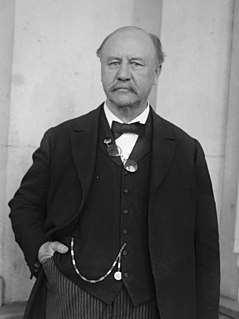
Samuel Moffett Ralston was a Democratic politician, the 28th Governor of and a United States Senator from the U.S. state of Indiana. Born into a large impoverished family, he took many jobs as a child including working in a coal mine. He taught school and studied law, becoming a prominent state lawyer.

Henry Frederick Schricker was the 36th and 38th Governor of the U.S. state of Indiana from 1941 to 1945 and from 1949 to 1953. He is the only Indiana governor elected to two non-consecutive terms, and the only governor between 1852 and 1977 to be elected to more than one term in office. His terms were marked by strong opposition party control of the Indiana General Assembly, which attempted to remove powers from the governor that had been granted during the Great Depression. Schricker fought the attempt in the state courts, and although his power was significantly reduced, the Indiana Supreme Court ruled in the case of Tucker v. Indiana that the governor was the chief executive of the state, and the legislature could not pass legislation that interfered with the division of powers.
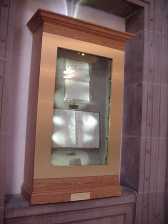
The Constitution of Indiana is the highest body of state law in the U.S. state of Indiana. It establishes the structure and function of the state government and enumerates specific rights of Indiana citizens. Under the principles of federalism, Indiana's constitution is subordinate only to the U.S. Constitution and federal law. Prior to the enactment of Indiana's first state constitution and achievement of statehood in 1816, the Indiana Territory was governed by territorial law. The state's first constitution was created in 1816, after the U.S. Congress had agreed to grant statehood to the former Indiana Territory. The present-day document, which was enacted in 1851, is the state's second constitution. It supersedes Indiana's 1816 constitution and has had numerous amendments since its adoption.
Lemuel Moss served as the sixth president of Indiana University, being the last of a long line of six "Preacher Presidents."

May Wright Sewall was an American reformer, who was known for her service to the causes of education, women's rights, and world peace. She was born in Greenfield, Milwaukee County, Wisconsin. Sewall served as chairman of the National Woman Suffrage Association's executive committee from 1882 to 1890, and was the organization's first recording secretary. She also served as president of the National Council of Women of the United States from 1897 to 1899, and president of the International Council of Women from 1899 to 1904. In addition, she helped organize the General Federation of Women's Clubs, and served as its first vice-president. Sewall was also an organizer of the World's Congress of Representative Women, which was held in conjunction with the World's Columbian Exposition in Chicago in 1893. U.S. President William McKinley appointed her as a U.S. representative of women to the Exposition Universelle (1900) in Paris.
Benjamin Parke was an American lawyer, politician, militia officer, businessman, treaty negotiator in the Indiana Territory who also served as a federal judge in Indiana after it attained statehood in 1816. Parke was the Indiana Territory's attorney general (1804–08); a representative to the territory's first general assembly (1805); its first territorial delegate to the U.S. Congress (1805–08); one of the five Knox County delegates to the Indiana constitutional convention of 1816; and a territorial court judge (1808–16). After Indiana attained statehood, Parke served as the first judge of the U.S. District Court for the District of Indiana (1817–35).
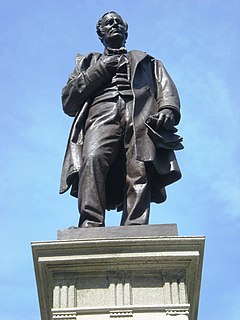
The Thomas A. Hendricks Monument is a public artwork by American artist Richard Henry Park and is located on the southeast corner of the Indiana Statehouse grounds in Indianapolis, Indiana. The monument is a tribute to Thomas A. Hendricks, the 21st Vice President of the United States. Hendricks was a former U.S. Representative and U.S. Senator from Indiana. He was the 16th Governor of Indiana and led the campaign to build the Indiana Statehouse.

Glenda Ritz is the former Superintendent of Public Instruction for Indiana. She was elected November 6, 2012, defeating incumbent Superintendent Dr. Tony Bennett in an upset election, and she took office with a state government dominated by Republicans who opposed her agenda and could block it. Among Indiana Democrats, she held the highest elected office in state government during her term of office. She is the first Democrat to serve in the office in 40 years and the first Democrat to win any down ballot race in the state since 1996.
Frank J. Hall was an American politician from the U.S. state of Indiana. Between 1909 and 1913 he served as Lieutenant Governor of Indiana.




